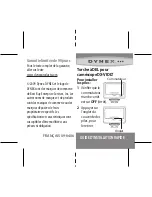
5.1.12. REPLACEMENT PROCEDURE FOR
LEADLESS (CHIP) COMPONENT
The
following
procedures
are
recommended
for
the
replacement of the leadless components used in this Unit.
1. Preparation for replacement
a. Soldering Iron
Use a pencil-type soldering iron using less than 30
watts.
b. Solder
Eutectic Solder (Tin 63%, Lead 37%) is recommended.
c.
Soldering time
Do not apply heat for more than 4 seconds.
d. Preheating
Leadless
capacitor
must
be
preheated
before
installation.
(130°C ~ 150°C, for about 2 minutes.)
Note:
a. Leadless component must not be reused after removal.
b. Excessive mechanical
stress and
rubbing of the
component electrode must be avoided.
2. Removing the leadless component
Grasp the leadless component body with tweezers and
alternately apply heat to both electrodes. When the solder
on both electrodes is melted, remove leadless component
with a twisting motion.
Note:
a. Do not attempt to lift the component off the board until
the component is completely disconnected from the
board by a twisting action. The leadless component is
attached to the PCB with glue. So carefully twist the
component when removing it so as not to break or
damage any fail under the component.
b. Take care not to break the copper foil on the printed
board.
Fig. 6-1
3. Installation of the leadless component
a. Presolder the contact points of the circuit board.
Fig. 6-2
b. Press the part downward with tweezers and solder both
electrodes as shown below.
Fig. 6-3
Note:
Do not glue the replacement leadless component to the
circuit board.
5.1.13. SPECIAL NOTE
All integrated circuits and many other semiconductor devices
are electrostatically sensitive and therefore require the special
handlings
techniques
described
under
the
"ELECTROSTATICALLY SENSITIVE (ES) DEVICES" section
of this service manual.
5.1.14. MODEL NO. IDENTIFICATION
MARK
Use Marks shown in the chart below to distinguish the different
models included in this Service Manual.
24
PV-D300 / VM-D100 / PV-L550 / PV-L600 / PV-L650 / VM-L450
Summary of Contents for Palmcorder Palmsight PV-L650
Page 3: ...1 1 1 MECHANICAL REPLACEMENT PARTS LIST 1 1 2 ELECTRICAL REPLACEMENT PARTS LIST 3 ...
Page 13: ...Fig 1 1 11 PV D300 VM D100 PV L550 PV L600 PV L650 VM L450 ...
Page 17: ...15 PV D300 VM D100 PV L550 PV L600 PV L650 VM L450 ...
Page 18: ...16 PV D300 VM D100 PV L550 PV L600 PV L650 VM L450 ...
Page 19: ...17 PV D300 VM D100 PV L550 PV L600 PV L650 VM L450 ...
Page 20: ...5 1 5 DESCRIPTION OF EMERGENCY INDICATIONS 18 PV D300 VM D100 PV L550 PV L600 PV L650 VM L450 ...
Page 41: ...6 1 9 3 Battery Catcher Unit Fig D13 3 39 PV D300 VM D100 PV L550 PV L600 PV L650 VM L450 ...
Page 49: ...6 2 7 P C B Angle Fig DM5 47 PV D300 VM D100 PV L550 PV L600 PV L650 VM L450 ...
Page 53: ...Fig DM9 2 6 2 12 A C Head Unit Fig DM10 51 PV D300 VM D100 PV L550 PV L600 PV L650 VM L450 ...
Page 60: ...Fig DM21 2 Fig DM21 3 59 PV D300 VM D100 PV L550 PV L600 PV L650 VM L450 ...
Page 63: ...62 PV D300 VM D100 PV L550 PV L600 PV L650 VM L450 ...
Page 69: ...7 3 2 INITIAL GUIDELINE 68 PV D300 VM D100 PV L550 PV L600 PV L650 VM L450 ...
Page 72: ...71 PV D300 VM D100 PV L550 PV L600 PV L650 VM L450 ...
Page 76: ...7 4 TEST POINTS AND CONTROL LOCATION 75 PV D300 VM D100 PV L550 PV L600 PV L650 VM L450 ...
Page 125: ...11 2 CAMERA AND FRAME SECTION PV D300 VM D100 PV L550 PV L600 PV L650 VM L450 126 ...
Page 126: ...11 3 FRAME SECTION A B PV D300 VM D100 PV L550 PV L600 PV L650 VM L450 127 ...
Page 127: ...11 4 FRAME AND LCD SECTION C D E F PV D300 VM D100 PV L550 PV L600 PV L650 VM L450 128 ...
Page 128: ...11 5 COLOR EVF SECTION A PV D300 VM D100 PV L550 PV L600 PV L650 VM L450 129 ...
Page 129: ...11 6 EVF SECTION B C D E F PV D300 VM D100 PV L550 PV L600 PV L650 VM L450 130 ...















































